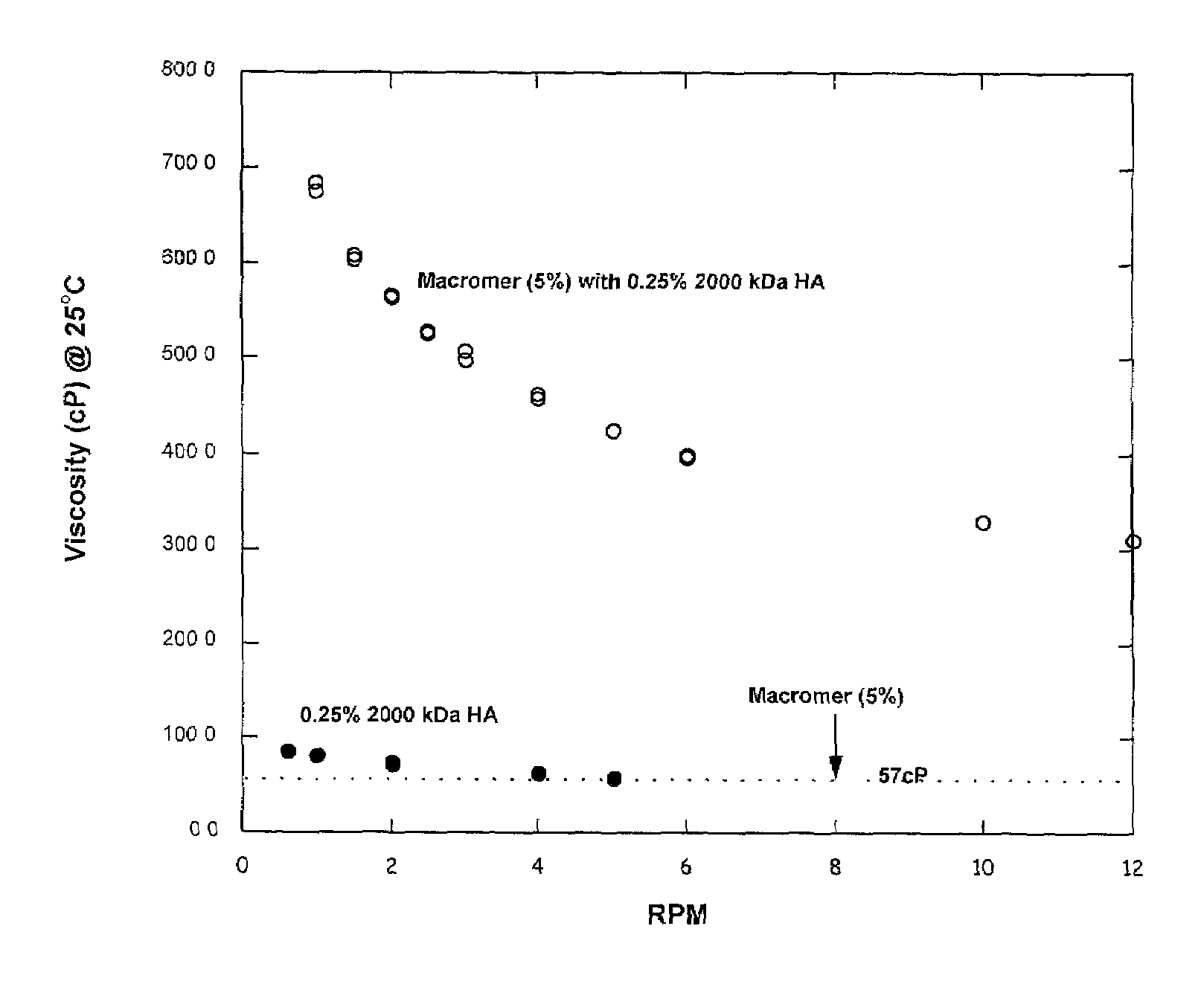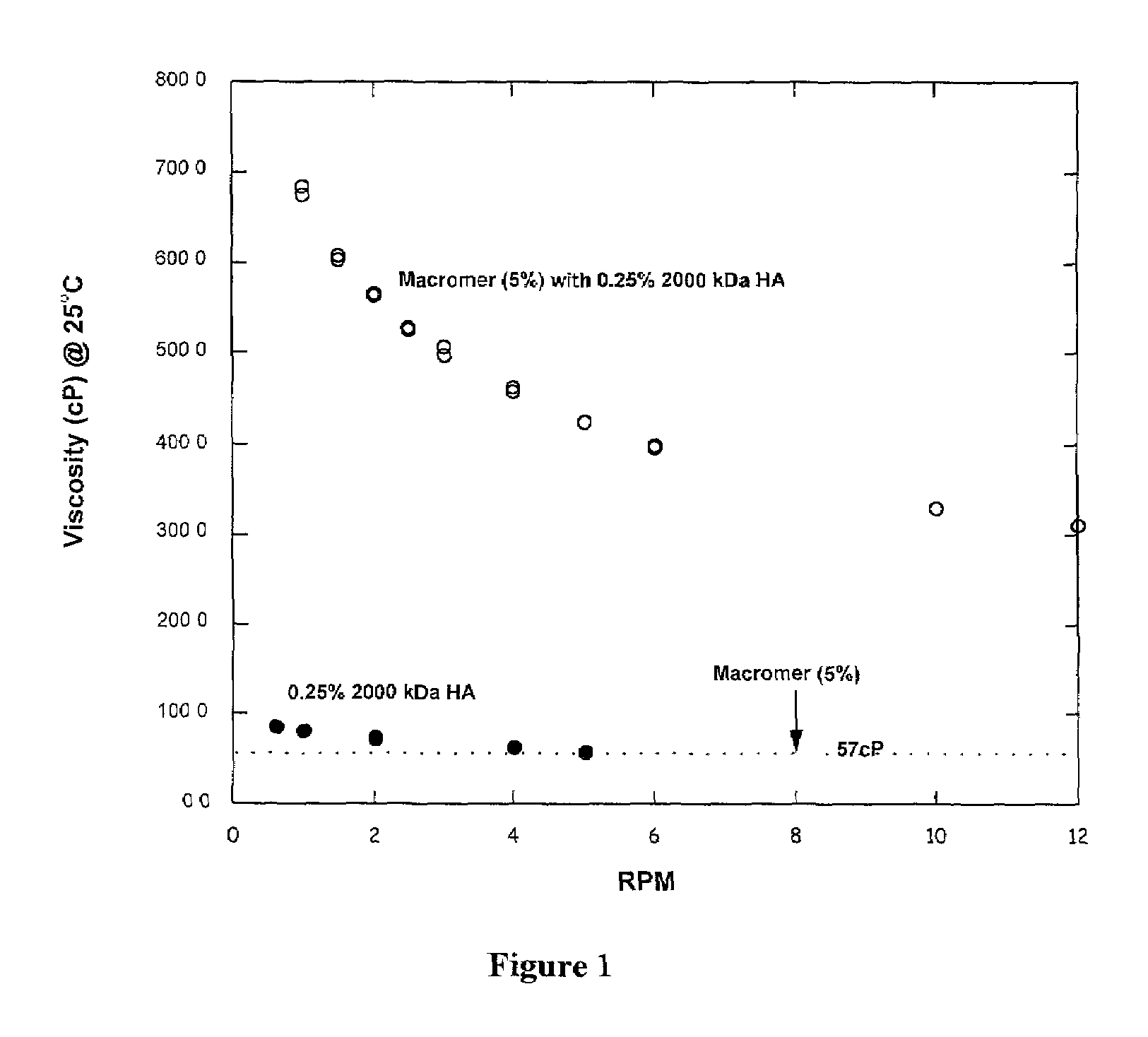Polyalkylene glycol viscosity-enhancing polymeric formulations
a technology of polyalkylene glycol and viscosity enhancement, which is applied in the field of polyalkylene glycolhyaluronic acid formulations, can solve the problems of difficult to achieve a sufficiently high viscosity, unable to facilitate cell entry in tissue engineering applications, and pags also have a tendency to swell, so as to achieve constant viscosity, increase shear rate, and change in apparent viscosity
- Summary
- Abstract
- Description
- Claims
- Application Information
AI Technical Summary
Benefits of technology
Problems solved by technology
Method used
Image
Examples
example 1
Viscosity and Modulus of 20KTLA and 35KTLA Solutions with and without 1% HA (500 kDa).
[0056]A 10 g aqueous formulation consisting of 1 g 20KTLA, 54 mg TEOA, 80 mg mono-potassium phosphate (KPhos), 40 mg vinylcaprolactam (VC), and 0.4 mg of Eosin-Y was prepared. To 5 g of this solution, 50 mg of 500 kDa sodium hyaluronate (HA) was added. Similarly, a 10 g aqueous formulation consisting of 2 g 35KTLA, 120 mg TEOA, 102 mg KPhos, 0.4 mg Eosin-Y, and 50 mg VC was prepared. To 5 g of this solution, 50 mg of 500 HA was added.
[0057]Table 1 summarizes the viscosities for each solution with and without HA. The viscosities of these solutions were obtained at 25° C. The moduli of the hydrogels, obtained after photopolymerization using visible light for 40, 80 or 180 seconds at 100 mW / cm2, are also summarized in Table 1.
[0058]The viscosities of the formulations with 1% 500 kDa HA were significantly higher than the corresponding macromer formulations without the added HA. The moduli of the hydrog...
example 2
Gel Formation by Aqueous Solutions Containing 35KTLA and HA.
[0060]A first aqueous 5.028 g formulation was prepared containing 0.9005 g 35KTLA, 0.0302 g HA, 0.03 g ferrous gluconate (Fe-Gluconate), and 25 μL VC. A second aqueous 5.028 g formulation was prepared containing 0.9005 g 35KTLA, 0.0302 g HA, 126.3 ppm t-Butylperoxide, and 25 μL VC.
[0061]Five drops of the first solution were added to 5 drops of the second solution, and the mixture was rapidly mixed resulting in the formation of a hydrogel almost instantaneously (i.e., in less than 2 seconds). The rapid formation of a gel suggests that the presence of HA did not interfere with chemical initiation reaction between ferrous ion and hydroperoxide.
example 3
Delivery of Aqueous Solutions Containing 35KTLA and HA.
[0062]The first aqueous solution described in Example 2 was loaded into one syringe and the second aqueous solution described in Example 2 was loaded into a second syringe. Both syringes were placed in a dual syringe holder. A device containing a 1 inch-long static mixer was attached to the end of the syringes. When the aqueous solutions were released from the syringes in a 1:1 ratio, the mixture gelled almost instantaneously.
PUM
| Property | Measurement | Unit |
|---|---|---|
| temperature | aaaaa | aaaaa |
| molecular weights | aaaaa | aaaaa |
| molecular weights | aaaaa | aaaaa |
Abstract
Description
Claims
Application Information
 Login to View More
Login to View More - R&D
- Intellectual Property
- Life Sciences
- Materials
- Tech Scout
- Unparalleled Data Quality
- Higher Quality Content
- 60% Fewer Hallucinations
Browse by: Latest US Patents, China's latest patents, Technical Efficacy Thesaurus, Application Domain, Technology Topic, Popular Technical Reports.
© 2025 PatSnap. All rights reserved.Legal|Privacy policy|Modern Slavery Act Transparency Statement|Sitemap|About US| Contact US: help@patsnap.com



